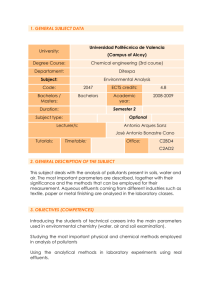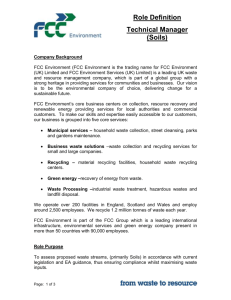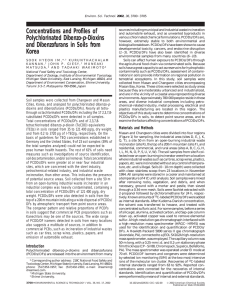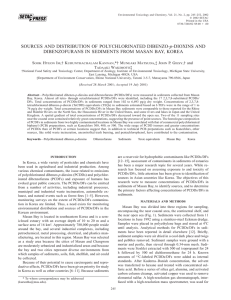Soil plays an important role in the global fate and distribution
advertisement
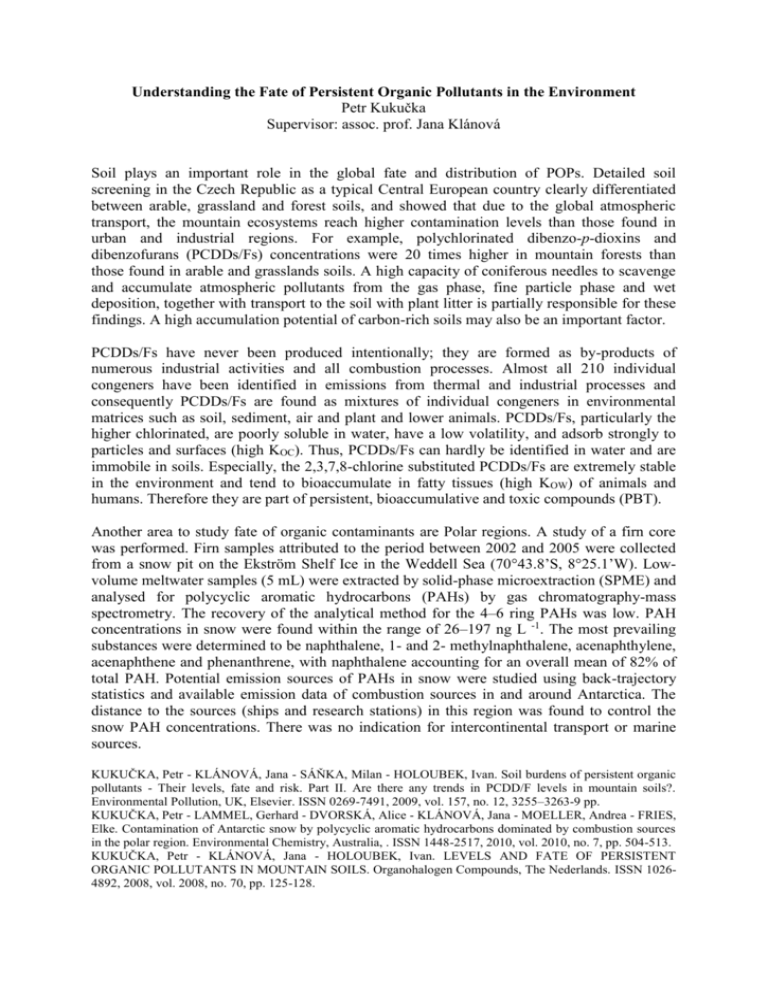
Understanding the Fate of Persistent Organic Pollutants in the Environment Petr Kukučka Supervisor: assoc. prof. Jana Klánová Soil plays an important role in the global fate and distribution of POPs. Detailed soil screening in the Czech Republic as a typical Central European country clearly differentiated between arable, grassland and forest soils, and showed that due to the global atmospheric transport, the mountain ecosystems reach higher contamination levels than those found in urban and industrial regions. For example, polychlorinated dibenzo-p-dioxins and dibenzofurans (PCDDs/Fs) concentrations were 20 times higher in mountain forests than those found in arable and grasslands soils. A high capacity of coniferous needles to scavenge and accumulate atmospheric pollutants from the gas phase, fine particle phase and wet deposition, together with transport to the soil with plant litter is partially responsible for these findings. A high accumulation potential of carbon-rich soils may also be an important factor. PCDDs/Fs have never been produced intentionally; they are formed as by-products of numerous industrial activities and all combustion processes. Almost all 210 individual congeners have been identified in emissions from thermal and industrial processes and consequently PCDDs/Fs are found as mixtures of individual congeners in environmental matrices such as soil, sediment, air and plant and lower animals. PCDDs/Fs, particularly the higher chlorinated, are poorly soluble in water, have a low volatility, and adsorb strongly to particles and surfaces (high KOC). Thus, PCDDs/Fs can hardly be identified in water and are immobile in soils. Especially, the 2,3,7,8-chlorine substituted PCDDs/Fs are extremely stable in the environment and tend to bioaccumulate in fatty tissues (high KOW) of animals and humans. Therefore they are part of persistent, bioaccumulative and toxic compounds (PBT). Another area to study fate of organic contaminants are Polar regions. A study of a firn core was performed. Firn samples attributed to the period between 2002 and 2005 were collected from a snow pit on the Ekström Shelf Ice in the Weddell Sea (70°43.8’S, 8°25.1’W). Lowvolume meltwater samples (5 mL) were extracted by solid-phase microextraction (SPME) and analysed for polycyclic aromatic hydrocarbons (PAHs) by gas chromatography-mass spectrometry. The recovery of the analytical method for the 4–6 ring PAHs was low. PAH concentrations in snow were found within the range of 26–197 ng L -1. The most prevailing substances were determined to be naphthalene, 1- and 2- methylnaphthalene, acenaphthylene, acenaphthene and phenanthrene, with naphthalene accounting for an overall mean of 82% of total PAH. Potential emission sources of PAHs in snow were studied using back-trajectory statistics and available emission data of combustion sources in and around Antarctica. The distance to the sources (ships and research stations) in this region was found to control the snow PAH concentrations. There was no indication for intercontinental transport or marine sources. KUKUČKA, Petr - KLÁNOVÁ, Jana - SÁŇKA, Milan - HOLOUBEK, Ivan. Soil burdens of persistent organic pollutants - Their levels, fate and risk. Part II. Are there any trends in PCDD/F levels in mountain soils?. Environmental Pollution, UK, Elsevier. ISSN 0269-7491, 2009, vol. 157, no. 12, 3255–3263-9 pp. KUKUČKA, Petr - LAMMEL, Gerhard - DVORSKÁ, Alice - KLÁNOVÁ, Jana - MOELLER, Andrea - FRIES, Elke. Contamination of Antarctic snow by polycyclic aromatic hydrocarbons dominated by combustion sources in the polar region. Environmental Chemistry, Australia, . ISSN 1448-2517, 2010, vol. 2010, no. 7, pp. 504-513. KUKUČKA, Petr - KLÁNOVÁ, Jana - HOLOUBEK, Ivan. LEVELS AND FATE OF PERSISTENT ORGANIC POLLUTANTS IN MOUNTAIN SOILS. Organohalogen Compounds, The Nederlands. ISSN 10264892, 2008, vol. 2008, no. 70, pp. 125-128.

